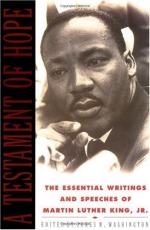
|
| Name: _________________________ | Period: ___________________ |
This test consists of 15 multiple choice questions and 5 short answer questions.
Multiple Choice Questions
1. Where were the African Americans allowed to sit when they took a bus to get somewhere?
(a) Front.
(b) Hanging from the side.
(c) Back.
(d) Nowhere.
2. The white power structure perpetuated the __________ that African Americans were moving too fast.
(a) Law.
(b) Myth.
(c) Argument.
(d) Speech.
3. In spite of the extreme ___________ in the area, Dr. King found little evidence of abuse towards each other.
(a) Fear.
(b) Wealth.
(c) Anger.
(d) Poverty.
4. What is NOT one of the ways in which oppression is responded to, according to Dr. King?
(a) Physical violence.
(b) Surrender.
(c) Nonviolences.
(d) Prayer sessions.
5. The personal experiences of Dr. King allowed him to develop a faith and a belief in the reality of a personal __________.
(a) Code.
(b) Honor.
(c) God.
(d) Truth.
6. The people, according to Dr. King, needed to overcome the ____________ that was segregation and the lack of civil rights.
(a) Dishonesty.
(b) Pain.
(c) Sin.
(d) Illness.
7. Nonviolence arouses a sense of ________ and builds reconciliation and redemption within a society.
(a) Shame.
(b) Truth.
(c) Distrust.
(d) Fear.
8. Dr. King discussed the idea that those who oppose __________ rarely give up privileges without intense opposition.
(a) Truth.
(b) God.
(c) Freedom.
(d) Racism.
9. The growth of __________ among African Americans would not allow people to revert to a subservient and demeaned class.
(a) Peace.
(b) Honor.
(c) Self respect.
(d) Truth.
10. Governor George ____________ declared his stubborn resistance to the desegregation and the March to Washington DC.
(a) Thurmond.
(b) Wallace.
(c) Evers.
(d) Smith.
11. What is NOT one of the things that Dr. King endured during his time in the Civil Rights movement?
(a) Home bombing.
(b) Jailing.
(c) Near fatal stabbing.
(d) Poisoning.
12. Dr. King wants his followers to only use the weapon of _________ as they battle for their basic rights.
(a) Money.
(b) Silence.
(c) Truth.
(d) Love.
13. Dr. King wants to point out a lot of things about the use of nonviolence. Nonviolence is not for __________, for example.
(a) Women.
(b) Cowards.
(c) Whites.
(d) Children.
14. One of the many wonders of the boycott and the nonviolent actions was the joining of many local __________ communities.
(a) Academic.
(b) Government.
(c) Religious.
(d) Neighborhood.
15. In the battle for freedom and for justice, Dr. King reminds followers to be ____________ and disciplined.
(a) Dignified.
(b) Strong.
(c) Smart.
(d) Quiet.
Short Answer Questions
1. The historic ________ ruling of the Supreme Court was nullified by the actions of the local and state governmental authorities.
2. What would have happened if African American people refused to give up their seats to a white person?
3. Dr. King believed that if the president had strong enough ___________ courage that problems could be solved.
4. Dr. King looks back on a year of people who had given the gift of _______, a true gift of love according to him.
5. ______________ in civil rights was responsible for this decline in civil rights being at the forefront of the public mind.
|
This section contains 450 words (approx. 2 pages at 300 words per page) |

|




